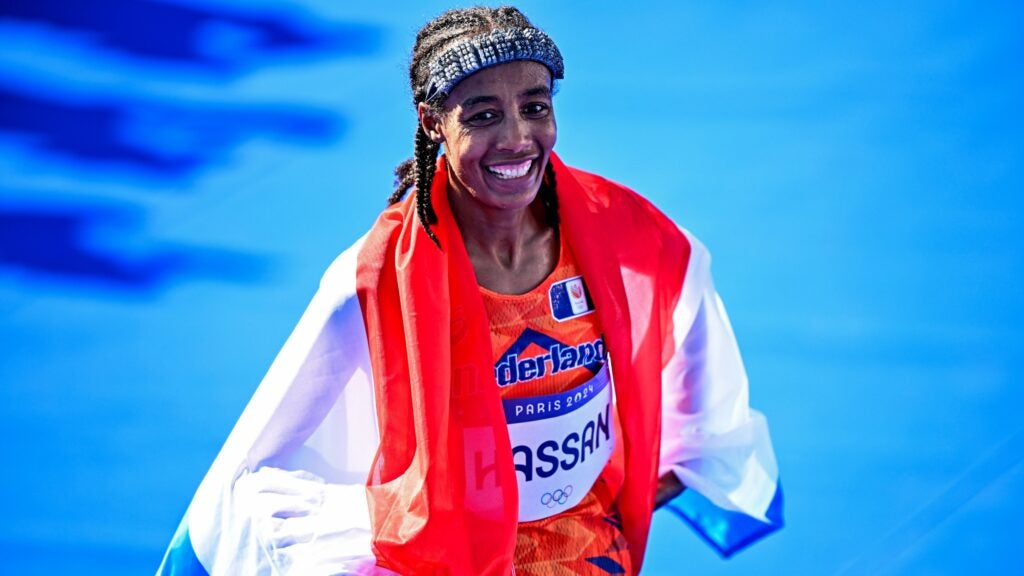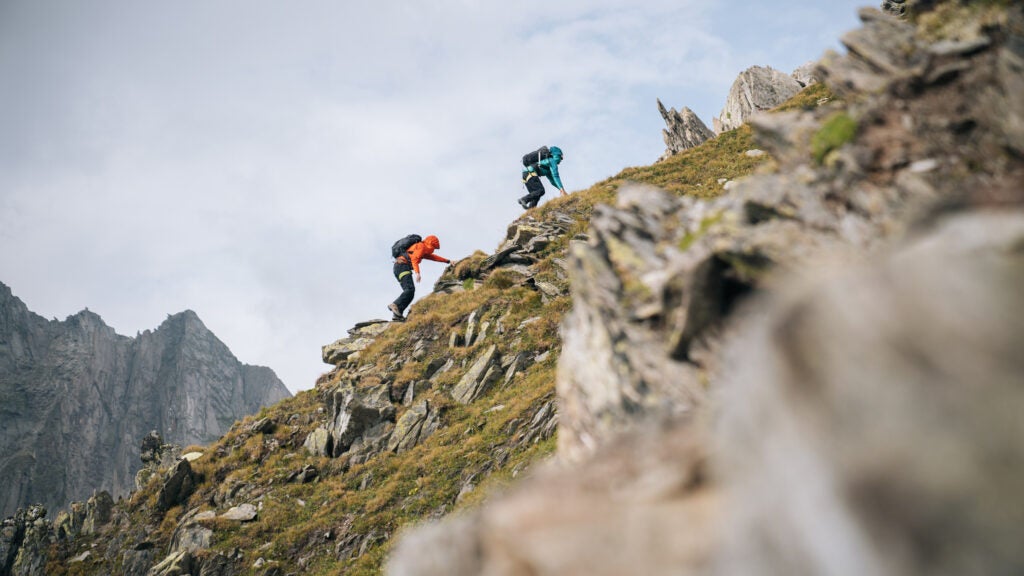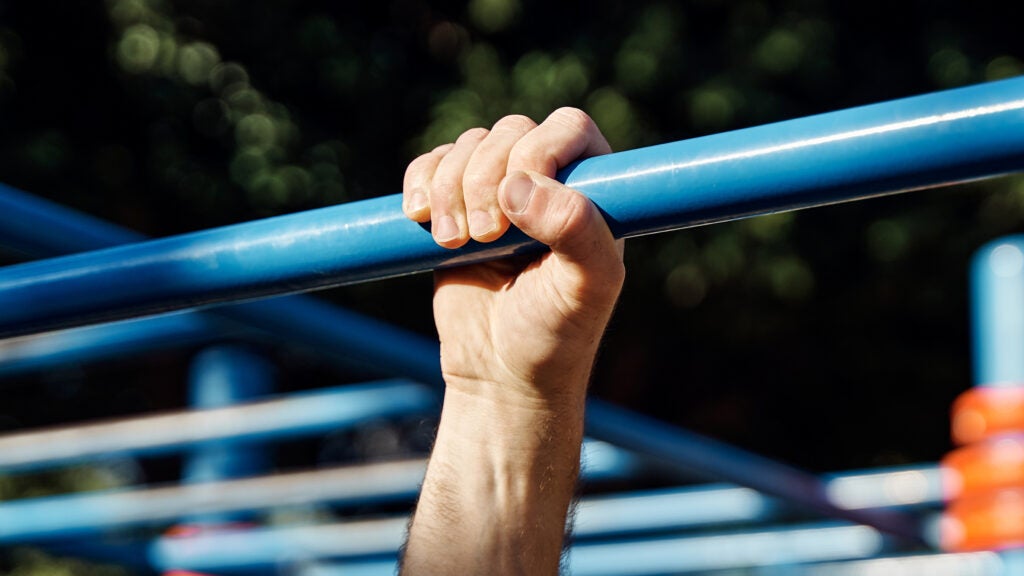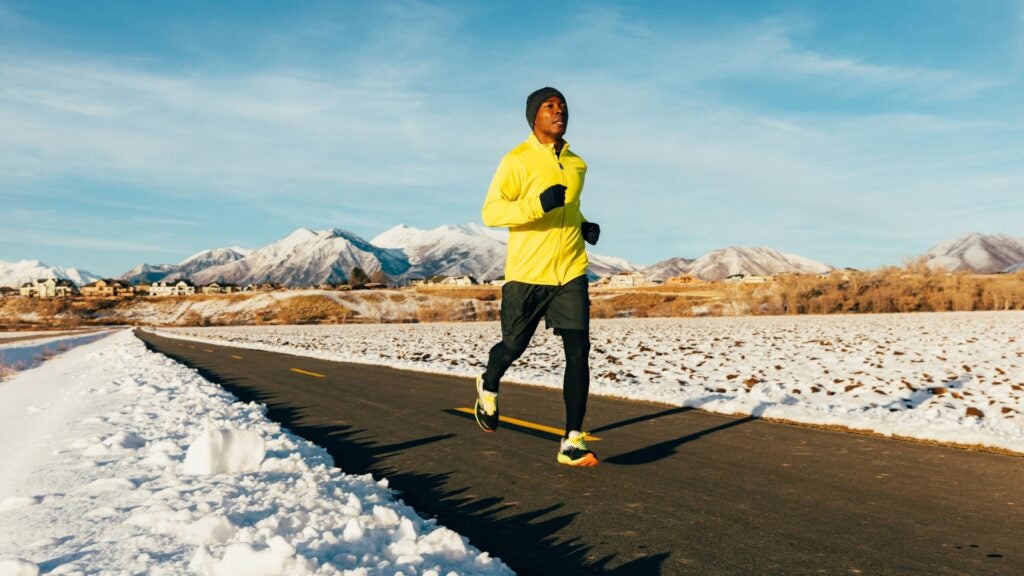As the best men’s marathoners in the world prepared to race in Paris last month, Jake Leschly was waiting at the 3K mark, peeping over the shoulder of the spectator next to him, who was streaming the race broadcast on his phone. Leschly is the CEO of a small three-person company called Omius, which makes a bulky, futuristic-looking headband that purports to keep you cool—and he was about to get a pleasant surprise: “They introduce Kipchoge,” Leschly recalls, “and I’m like, ‘Son of a bitch, he’s wearing it!’”
Omius’s headband first showed up in the triathlon world back in 2019. The fledgling company took a hiatus during the pandemic, but resumed sales in 2022. Triathletes have been enthusiastic: according to Leschly, 43 of the 53 pros at last year’s Women’s Ironman World Championship in Kona wore it, along with a third of the 2,000 age-group competitors.
But the headband’s conspicuous presence at this summer’s Olympic marathons—along with Kipchoge, other notables wearing it included Sifan Hassan and Hellen Obiri, the gold and bronze medalists in the women’s race, and Bashir Abdi, the silver medalist in the men’s race—brought it to a new audience. In the week after the Olympics, Omius sold half as many headbands as they did in all of 2023.
So far, Omius has been relying on a simple strategy to convince people that their headband works: give it to them and let them try it. That’s how they got elite triathletes on board, and it’s how they got Kipchoge and Hassan to wear it. They’ve never paid any athlete, according to Leschly; they just give them a sample and hope that the headband’s performance speaks for itself. That’s great, except for the long history of athletic fads and the infinite human capacity for self-deception. PowerBand bracelets, as I never tire of pointing out, were enormously popular with elite athletes despite being nothing but a piece of plastic.
Fortunately, the first peer-reviewed study of the Omius headband appeared just a few weeks ago. It’s an independent study from a research group at the Université de Sherbrooke in Canada, led by pro triathlete and ultrarunner Antoine Jolicoeur Desroches and senior author Éric Goulet, published in the Journal of Thermal Biology.
Omius didn’t fund the study; in fact, they don’t like it. Leschly sent me six pages of comments and critiques on the study from Omius founder Gustavo Cadena, who developed the headband’s cooling technology. It’s certainly not the final word on Omius, but I do think it provides some valuable data—and, despite Cadena’s concerns, some reasons to be intrigued.
How the Headband Works

The one simple trick that Omius relies on is to increase the surface area available for evaporation. The headband contains 20 cooling units, each of which consists of nine mini-towers of porous and heat-conducting graphite. Overall, this increases the surface area of the relevant patch of your forehead by a factor of five. The cooling units can be swapped in and out; Omius also makes visors and caps, and is developing other garments.
As long as you keep the headband damp and have airflow passing across it, water will evaporate from this large surface area, drawing heat away from your forehead and creating a cooling effect. Sweat can help moisten the cooling units, but in most situations you’ll need to periodically splash or spray them with water. You’ll generate enough airflow simply by running outdoors, but to use the headband indoors on a treadmill or stationary bike, you’ll need a fan. Leschly advises against cycling outdoors with it, because the cooling units don’t have appropriate impact properties.
There’s not really any doubt that the design “works” in the sense that it creates a cooling effect. Evaporation, and its relationship to surface area, are not new or untested ideas. Probably the best endorsement comes from Desroches’s attempts to create a placebo headband for his study, which was crucial for reasons we’ll return to below.
Desroches went to extraordinary lengths to make realistic sham cooling cubes with a 3D printer, spray painted them to mimic the speckled look of the real thing, then fitted them into the authentic Omius headband. But to mimic the sensation of the real headband, he had to store the sham one in a refrigerator—because the real headband is so noticeably cold as soon as you put it on.

You might think that the goal of sucking all this heat from your forehead is to cool your whole body down. That’s been the claim for some previous cooling devices, like palm-coolers that purported to lower your core temperature. But Omius isn’t going down that road. “It obviously does not change your core temperature,” Leschly says. “Nothing changes your core temperature.” Instead, he says, it’s a local effect that makes you feel cooler, enabling you to go faster. That’s not a crazy claim: one study, for example, found that applying a tiny amount of heat through a heat pad caused cyclists to slow down even though their core temperature didn’t change. But it makes Omius’s claims much harder to test.
What the New Study Found
Desroches’s study involved ten volunteers who completed a running test twice: once with the real headband and once with the sham headband. The test involved 70 minutes of running in a heat chamber set to 95 degrees Fahrenheit with 56 percent humidity at a predetermined moderate pace, followed by an all-out 5K time trial. The researchers measured all sorts of physiological data, including core temperature with a rectal thermometer, skin temperature with four different probes, and forehead temperature with an infrared thermometer.
During the 70-minute run, the headband reduced forehead temperature and improved thermal comfort, but didn’t change core temperature or heart rate. That’s pretty much what you’d expect. During the 5K time trial, on the other hand, there were no significant differences in any of the relevant parameters, including temperature, comfort, or overall time. On the surface, that’s bad news for Omius. One of Cadena’s objections is that no one sprayed the headbands during the 5K (compared to spraying every ten minutes during the 70-minute run), so they might have dried out. And more generally, with just ten subjects, there would have had to be a huge performance difference to produce a statistically significant result.
Desroches remains open to the idea that even a slight decrease in the perception of heat could be pleasant and possibly even performance-enhancing for athletes, as do I. But if nothing else, the new results put a ceiling on how big the effect is. The headbands aren’t the new supershoes, and they’re not what won Hassan her Olympic gold.
Is There a Cheaper Option?
It’s probably worth mentioning that the basic headband with cooling pieces currently costs $204. That’s considerably more than other cooling options like, say, pouring water on your head. As it happens, there’s another new study, just published in the International Journal of Sports Physiology and Performance by a team led by Samuel Chalmers of the University of South Australia, that explores the benefits of pouring water on yourself during hot runs.
While the details differ, the two studies are remarkably similar. In this case, 13 runners did a 10K time trial followed an hour later by a 60-minute moderate run, in a room set at 87 degrees Fahrenheit and 47 percent humidity. They completed this protocol twice; in one of the sessions, they poured two cups of water over their head, face, and arms every 2.5K or ten minutes. As with the headband, water dousing made them feel cooler and lowered their skin temperature, but didn’t change their core temperature. There is one key difference compared to the headband, though: they ran 1.0 percent faster in the water dousing time trial, which was a statistically significant benefit.
Because of the differences in protocol—the lack of a placebo trial in the water dousing study, for example—it would be a mistake to simply say “Pouring water on your head makes you faster, and fancy headbands don’t.” Both approaches seem to reliably make you feel cooler. More research will be needed to nail down to what extent, if at all, that translates into better race times. And only you can decide whether that potential benefit is worth $200 to you. But there is one conclusion we can be confident about: if you do buy an Omius headband, when you’re spraying it with water, you might as well soak yourself too.
For more Sweat Science, join me on Threads and Facebook, sign up for the email newsletter, and check out my book Endure: Mind, Body, and the Curiously Elastic Limits of Human Performance.
Source link










